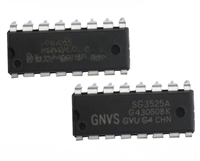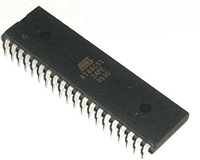MC3374
CIRCUIT DESCRIPTION
The MC3374 is an FM narrowband receiver capable of
operation to 75 MHz. The low voltage design yields low
power drain and excellent sensitivity in narrowband voice
and data link applications. In the typical application the mixer
amplifies the incoming RF or IF signal and converts this
frequency to 455 kHz. The signal is then filtered by a 455 kHz
ceramic filter and applied to the first intermediate frequency
(IF) amplifier input, before passing through a second ceramic
filter. The modulated IF signal is then applied to the limiting IF
amplifier and detector circuitry. Modulation is recovered by a
conventional quadrature detector. The typical modulation
bandwidth available is 3.0 to 5.0 kHz.
The audio buffer is a noninverting amplifier with a nominal
voltage gain of 4.0 V/V. This buffer is self–biasing so its input
should be ac coupled. The two buffers, when applied as
active filters, can be used together to allow simultaneous
audio and very low speed data reception. Another possible
configuration is to receive audio only and include a
noise–triggered squelch.
The comparator is a noninverting type with an open
collector output. Typically, the pull–up resistor used between
Pin 14 and V
is 100 kΩ. With R = 100 kΩ the comparator
CC
L
is capable of operation up to 25 kHz. The circuit is
self–biasing, so its input should be ac coupled.
Features available include buffers for audio/data
amplification and active filtering, on board voltage regulator,
low battery detection circuitry with programmable level, and
receiver disable circuitry. The MC3374 is an FM utility
receiver to be used for voice and/or narrowband data
reception. It is especially suitable where extremely low power
consumption and high design flexibility are required.
The regulator is a 1.07 V reference capable of sourcing
3.0 mA. This pin (Pin 17) needs to be decoupled using a
1.0–10 µF capacitor to maintain stability of the MC3374.
All three V s on the MC3374 (V , V
, V
) run on
CC
CC CC2 CC3
the same supply voltage. V
is typically decoupled using
CC
capacitors only. V
the RC bypasses shown in Figure 1. Eliminating the resistors
on the V and V bypasses may be possible in some
and V should be bypassed using
CC3
CC2
CC2
CC3
APPLICATION
applications, but a reduction in sensitivity and quieting will
likely occur.
The MC3374 can be used as a high performance FM IF for
the use in low power dual conversion receivers. Because of
the MC3374’s extremely good sensitivity (0.6 µV for 20 dB
(S+N/N, see Figure 3)), it can also be used as a stand alone
single conversion narrowband receiver to 75 MHz for
applications not sensitive to image frequency interference.
An RF preamplifier will likely be needed to overcome
preselector losses.
The oscillator is a Colpitts type which must be run under
crystal control. For fundamental mode crystals choose
resonators, parallel resonant, for a 32 pF load. For higher
frequencies, use a 3rd overtone series mode type. The coil
L2 and RD resistor are needed to ensure proper operation.
The best adjacent channel and sensitivity response occur
when two 455 kHz ceramic filters are used, as shown in
Figure 1. Either can be replaced by a 0.1 µF coupling
capacitor to reduce cost, but some degradation in sensitivity
and/or stability is suspected.
The detector is a quadrature type, with the connection
from the limiter output to the detector input provided
internally. A 455 kHz LC tank circuit must be provided
externally. One of the tank pins (Pin 8) must be decoupled
using a 0.1 µF capacitor. The 56 kΩ damping resistor (see
Figure 1), determines the peak separation of the detector
(and thus its bandwidth). Smaller values will increase the
separation and bandwidth but decrease recovered audio and
sensitivity.
The data buffer is a noninverting amplifier with a nominal
voltage gain of 2.7 V/V. This buffer needs its dc bias
(approximately 250 mV) provided externally or else
debiasing will occur. A 2nd order Sallen–Key low pass filter,
as shown in Figure 1, connecting the recovered audio output
to the data buffer input provides the necessary dc bias and
some post detection filtering. The buffer can also be used as
an active filter.
The low battery detection circuit gives an NPN open
collector output at Pin 20 which drops low when the MC3374
supply voltage drops below 1.2 V. Typically it would be pulled
up via a 100 kΩ resistor to supply.
The 1.2 V Select pin, when connected to the MC3374 supply,
programs the low battery detector to trip at V
< 1.1 V. Leaving
CC
this pin open raises the trip voltage on the low battery detector.
Pin 15 is a receiver enable which is connected to V for
CC
normal operation. Connecting this pin to ground shuts off
receiver and reduces current drain to I
< 0.5 µA.
CC
APPENDIX
Design of 2nd Order Sallen–Key Low Pass Filters
C1
R1
Input
Low Pass Output
+
–
R2
0 to f Hz
C2
o
A
= K
vo
Bias
The audio and data buffers can easily be configured as active
low pass filters using the circuit configuration shown above.
The circuit has a center frequency (f ) and quality factor (Q)
o
given by the following:
1
f
o
2
R1R2C1C2
1
Q
R2C2
R1C1
R1C2
R2C1
R1C1
R2C2
(1–K)
If possible, let R1 = R2 or C1 = C2 to simplify the above
equations. Be sure to avoid a negative Q value to prevent
instability. Setting Q
filter response.
1
2
0.707 yields a maximally flat
6
MOTOROLA ANALOG IC DEVICE DATA






 SG3525资料手册详解:SG3525参数分析、引脚说明、应用介绍
SG3525资料手册详解:SG3525参数分析、引脚说明、应用介绍

 AT89C51单片机资料手册详细解析及应用示例
AT89C51单片机资料手册详细解析及应用示例

 CP2102资料手册解读:CP2102引脚说明、关键参数分析
CP2102资料手册解读:CP2102引脚说明、关键参数分析

 资料手册解读:UC3842参数和管脚说明
资料手册解读:UC3842参数和管脚说明
